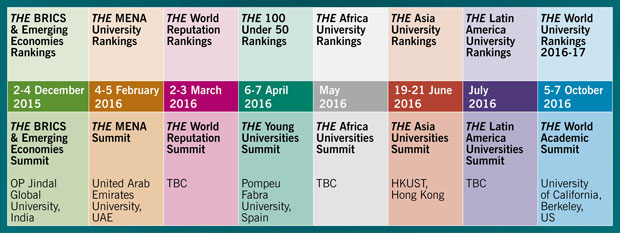View the full World University Rankings 2015-2016 results
World University Rankings: three words that over the past decade have assumed enormous significance in higher education.
Their rise to global prominence has not been without controversy: there are those who feel that universities, those hives of scholarly endeavour, cannot be organised in a linear hierarchy. Others argue that while rankings are a powerful tool in the right hands, they can also be misused by those who fail to understand the unique academic ecosystem.
The truth is that rankings measure only what is measurable, and neither can nor should claim to capture everything that a university is and represents. This understanding has been at the heart of the evolution of the Times Higher Education World University Rankings since their launch in 2004.
The rankings methodology, explains Trevor Barratt, managing director at THE’s parent company TES Global, was developed via comprehensive consultation with academics and university leaders.
“The whole ethos is one of transparency and collaboration,” Barratt explains. “Universities aren’t simple organisations with one or two very obvious performance indicators: they are complex living and breathing institutions, and it’s vital that we understand that and shape the rankings around the issues that matter to scholars and students, as well as to institutional leaders.”
One of THE’s differentiating features compared with other global rankings systems has been its willingness to make changes as higher education has evolved.
“We’ve been consistent in our methodological approach, but we haven’t been afraid to take big decisions over the years,” says Barratt.
Last year, THE announced that for the first time it would be taking the majority of its data collection in-house, with a new team of analysts establishing direct relationships with universities around the world to develop the stream of institutional information that underpins many of the rankings criteria.
In a second change, it announced that the rankings’ research publication data would henceforth be drawn from Elsevier’s Scopus – the world’s largest abstract and citation database of peer-reviewed academic literature.
Phil Baty, editor of the THE World University Rankings, said at the time that the switch would allow for analysis of “a deeper range of activity from a wider range of institutions, including those from emerging economies that account for a growing portion of the world’s research output”.
THE Data
Less than a year on, THE’s in-house data team is in place, led by Duncan Ross, data and analytics director. It has already doubled the number of global institutions participating in this year’s World University Rankings.
“We have now collected well over 100,000 data points from 1,126 universities based across 88 countries,” Ross says.
This information has been combined with 400,000 data points collected from THE’s annual Academic Reputation Survey, plus the not inconsiderable matter of 51 million citations of 11.3 million research papers indexed by Scopus and published over a five-year period to 2014.
Together, these data form the rankings published in these pages and launched at the World Academic Summit 2015, held at the University of Melbourne this week.
Asked to explain the new approach’s key benefits, Ross says that not only are the rankings more comprehensive than before, but the underlying database of university performance is also among the richest in the world, allowing for greater depth of insight.
“Our new data services allow universities to benchmark themselves against their peers and set intelligent strategic goals,” Ross says. “Institutions can access the rankings data and unlock different levels of information through a dedicated website offering interactive, graphical analyses designed to provide clear action points.”
THE Students
For many – if not all – of the institutions that appear in this year’s rankings, one of those action points concerns student recruitment, particularly international student recruitment.
While THE has a long pedigree as a provider of academic content, including news and expert commentary, it has previously focused less on the student community. However, with the rankings’ evolution and their adoption as a starting point for millions of prospective students considering where in the world to study, that has changed. For the first time, THE is developing a strand of its business focused specifically on this group.
Madeleine Evans, product director, World University Rankings, is leading this new area of business and explains that the student audience has distinct needs, both from a data perspective and in terms of the content students are seeking to help them make the right choices.
“We’re used to dealing with the academic audience, but like universities that now have to compete globally for students, we’ve had to build up our expertise to understand the student audience, too,” Evans explains. “Our starting point is that we have an incredibly valuable student resource in the rankings: we can be confident about that because they have been coming to us in their millions, even though our focus traditionally has been on the academic and institutional audience.
“In many ways that’s the perfect audience – one that comes to you even though you haven’t been chasing it. It highlights the extent to which students are now making global choices about where to study and where to make that investment in their future.
“We’re acutely aware of our responsibility to help them make the right decision. We will be drawing on our long heritage of working with universities in a spirit of collaboration, but also with the integrity that is the foundation of THE’s approach, to ensure we reward their trust.”
Evans points out that research by international student recruitment agency IDP has shown that a university’s global reputation – embodied by its ranking position – is the number one factor in students’ choice of where to study, beating tuition fees, location and even course content.
She adds that the same research found the THE World University Rankings to be the most trusted of the competing global rankings systems. With the release of eight THE rankings planned for 2015-16, the team expects to reach more than 17 million individuals, many of whom will be using the tables to help evaluate options for undergraduate or postgraduate study.
One of the innovations to have been introduced to the THE website this year is a university search environment, separate from the ranking tables, with profiles of more than 1,000 global institutions.
These profiles and the associated student-facing platform will allow universities to tailor their messages to the student audience more effectively, says Evans.
For the first time, the profiles will allow students to easily dig into the institutional strengths of the universities that interest them. A new system of badges will also highlight the key performance areas in which each institution excels.
THE Branding Solutions
This approach is important because points of differentiation matter hugely in a globalised higher education system.
At a time when all research-intensive universities are striving to be “world class”, with overlapping missions and priorities, the market can start to look increasingly homogeneous, making it harder than ever for students to make informed choices.
Universities face a similar problem at the academic level, as they seek to carve out global reputations in specific fields and build the most valuable partnerships and collaborations.
This is one of the reasons why rankings have become so important to globally engaged institutions. As Sir Steve Smith, vice-chancellor of the University of Exeter, explained in a recent interview with THE: “It’s the concept of assortative mating: if you are seventh in the world, you don’t mate with number 497.” Ambitious global universities “have to be in that research grouping at the top”, he added. “It’s not ‘nice to have’, it’s essential.”
This ambition to improve performance and climb up the rankings is shared by serious research universities around the world, and highlights the importance of a strong global profile.
It is a point underlined by Nick Pirog, commercial director, World University Rankings. He says that in addition to benefiting their student-facing activities, universities will find that enhanced profiles on the rankings site will also allow them to shape worldwide understanding of their institutional strengths and trajectory among academics, policy-makers and potential industrial partners.
As an established provider of higher education news and commentary, THE is also well placed to raise institutional profiles through its publications and digital editions, Pirog adds. What’s new, however, and available as a result of THE’s data collection reforms, is the option for universities to access the underlying data that determine their ranking position relative to their closest rivals.
“We know that many universities are using the rankings to drive performance improvements – for example, by including targets for ranking position in their strategic plans,” Pirog explains. “What we’ve sought to do is to help clients understand to a far greater degree why they are ranked where they are – the areas of institutional strength and relative weakness that are driving them up the tables or holding them back.
“We also know that institutions will want to benchmark their performance against the universities they compete with, both domestic-ally and across the globe.
“For example, you may be making year-on-year improvements, but how do those gains compare with the improvements being made by other comparable institutions? How is that affecting movement within the rankings? Are you standing still in certain areas while rivals progress? And would an understanding of performance in a small number of specific criteria help you to set the action points required to enable you to meet your strategic goals?”
For Pirog, this isn’t just about ranking performance; it is also about doing what universities should be doing, regardless of the tables – striving to improve across all key areas of activity, from teaching and learning to research.
“That’s what makes the THE data products such a rich resource and something we’re proud to be able to offer – ultimately, this is about helping universities to excel,” he says.
THE Summits
While this year’s rankings recalibration and the ways in which THE engages with academics and students are focused firmly on data, another of the brand’s strengths is its face-to-face contact with the audience it serves, Barratt says.
In the past 12 months, THE has developed a hugely successful Summit series, built around its flagship World Academic Summit, this year hosted in partnership with the University of Melbourne.
Nicola Iberi, commercial director at THE, says that the aim of the Summit series is to bring together pre-eminent thought leaders in higher education, industry and government to help develop a common understanding of what it means to be a world-class university.
“We’re fortunate to spend a great deal of time talking to universities and the people who live and breathe higher education, so it was a natural step for us to bring those individuals together,” Iberi says. “Universities are complex organisations that rely on constant innovation and strong leadership to thrive. Accordingly, our approach was to develop events in partnership with leading global universities to give leaders and scholars a space to talk through common issues, develop shared agendas and build networks.
“Sometimes we all benefit from stepping outside our immediate surroundings to share our thoughts with others in similar positions: that’s what the Summit series aims to facilitate.”
Following the World Academic Summit in Melbourne, events scheduled for the forthcoming academic year include the BRICS and Emerging Economies Summit in India and the Asia Universities Summit in Hong Kong (see below for the full schedule). The intention throughout is to partner with some of the world’s most prestigious, innovative and exciting higher education institutions. Next year’s series will culminate with the World Academic Summit 2016, to be held in partnership with the University of California, Berkeley.
THE Hiring Solutions
One of the common priorities for all university leaders is recruiting the best staff, both academic and administrative.
If the global flow of students is a relatively new phenomenon, academic mobility has always been a feature of higher education. But as universities adjust their sights to compete on a global stage, seeking out the best staff and leadership teams has also become an international operation.
This, according to Barratt, is a crucial piece in the jigsaw puzzle, completing THE’s suite of services that have the combined aim of helping universities to improve their performance across the board.
“We have a huge amount of experience in helping universities to find and recruit the best academic staff and leadership teams, but just like the universities themselves, we’ve had to evolve as the market has evolved,” he says.
A major step in that evolution came earlier this year, when TES Global – THE’s parent company – acquired Australian-based digital jobs network UniJobs, with a remit to focus on the recruitment needs of universities in Australasia, South Africa and Canada.
Polly Fryer, hiring solutions director at THE, says that UniJobs will complement THE’s traditional recruitment strengths in established higher education systems, including the UK (where THE is headquartered).
She also stresses the importance of THE’s breadth of activity in supporting universities’ recruitment needs. “The presence of our jobs platform alongside our award-winning journalism, influential rankings and revamped data products ensures that roles advertised with THE are seen by a truly engaged global audience of scholars and leaders working in world-class institutions,” Fryer says.
Times Higher Education
This comprehensive approach is underpinned by a deep understanding of what makes universities tick, fuelled by THE’s long heritage as trusted provider of news, analysis, comment and debate. For more than 40 years, its journalists have reported on the latest developments, held university leaders and policymakers to account, given a voice to academic staff and delivered insight and analysis in a rapidly changing global landscape.
John Gill, editor of THE, says that this heritage is the foundation on which the wider offering has been built – a guarantee of integrity and engagement. “There are thousands of universities around the world, and while the environments they operate in differ, experience has taught us that the issues facing academia are often shared,” Gill says. “The massification of higher education; how to maintain quality; future funding models; and ways to measure and manage performance – these are all issues that worry university presidents from Boston to Beijing, from Melbourne to Manchester.”
THE’s worldwide audience averages 1.4 million unique visitors a month, and Gill says that as higher education has globalised, so the publication’s content has focused on universal issues.
“For example, we track changes in teaching and learning, in research, in higher education careers and academic disciplines, as well as the policy environment in which universities operate,” he explains. “Those are all common concerns across higher education systems.”
One of the distinguishing features of THE’s approach is that it draws on the expertise of some of the world’s most celebrated academics and university leaders, alongside that of its own writers and data analysts. The result is a flow of insight and opinion from the world’s most respected universities, as well as industry, thinktanks and government.
Gill adds: “Our focus on university performance is underpinned by our data expertise, which has long been a pillar of our journalism. This ensures that subscribers to THE and its global digital editions remain informed of forthcoming trends and what they will mean in practice. It’s the reason our readers trust us to keep them ahead of the curve.”
THE Summit and rankings timeline, 2015-16
Register to continue
Why register?
- Registration is free and only takes a moment
- Once registered, you can read 3 articles a month
- Sign up for our newsletter
Subscribe
Or subscribe for unlimited access to:
- Unlimited access to news, views, insights & reviews
- Digital editions
- Digital access to THE’s university and college rankings analysis
Already registered or a current subscriber? Login





